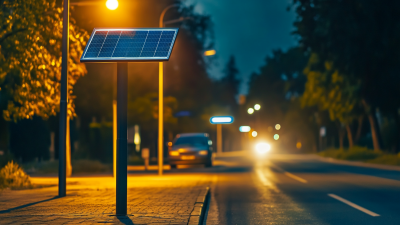News
How Solar Street Lamps are Revolutionizing Urban Lighting and Enhancing Sustainability
Solar Street Lamps are emerging as a transformative solution in urban lighting, significantly enhancing sustainability and reducing energy costs. According to a report by MarketsandMarkets, the global smart street lighting market is projected to reach $17.7 billion by 2025, driven by the increasing demand for energy-efficient and environmentally friendly lighting solutions. Solar Street Lamps, which utilize renewable energy sources, are not only decreasing reliance on traditional power grids but also lowering CO2 emissions. A study by the International Renewable Energy Agency (IRENA) found that implementing solar street lighting can reduce energy consumption by up to 80% compared to conventional street lights. As cities strive for sustainability and resilience against climate change, the adoption of Solar Street Lamps presents a practical and innovative approach to urban infrastructure, paving the way for smarter and greener cities.

The Growing Importance of Solar Street Lamps in Urban Environments
The Growing Importance of Solar Street Lamps in Urban Environments
As cities expand and the demand for sustainable solutions increases, solar street lamps are becoming an essential component of urban infrastructure. According to a report by the International Renewable Energy Agency (IRENA), the adoption of solar lighting technologies has surged over 70% in urban areas since 2020. This is not just a trend, but a necessity as cities aim to reduce their carbon footprints. Solar street lamps offer a compelling alternative to traditional lighting systems by harnessing solar energy, which significantly cuts down on greenhouse gas emissions and decreases reliance on fossil fuels.
Moreover, solar street lamps can lead to substantial cost savings for municipalities. A study by the U.S. Department of Energy found that solar street lighting can reduce energy costs by 55% to 90% compared to conventional street lighting systems. This financial advantage allows cities to reallocate funds to other critical areas, such as public safety and infrastructure development.
Tips: When considering the implementation of solar street lamps in urban settings, ensure they are strategically placed to maximize sunlight exposure. Additionally, investing in smart solar lamps equipped with LED technology can enhance energy efficiency while providing better illumination for pedestrian safety. It's essential to engage with local communities to assess their needs and preferences, ensuring the successful integration of these sustainable lighting solutions.

Key Benefits of Implementing Solar Street Lamps in Cities
The implementation of solar street lamps in urban areas offers numerous benefits that significantly enhance sustainability. One of the most compelling advantages is the reduction in energy costs. Traditional street lighting relies heavily on electricity from the grid, which can be expensive and environmentally taxing. In contrast, solar street lamps harness sunlight to generate energy, resulting in drastically lower operating costs for municipalities. This not only frees up funds for other crucial public services but also aligns with the global push towards renewable energy sources.
Another key benefit of solar street lamps is their minimal environmental impact. These fixtures typically use LED technology, which is more energy-efficient than conventional lighting. Furthermore, because they operate independently of the grid, they reduce reliance on fossil fuels, thereby decreasing greenhouse gas emissions. Additionally, solar street lamps can be installed in remote or underserved areas where extending traditional electrical infrastructure is impractical. This feature promotes equity in urban lighting, ensuring that all communities have access to safe and reliable lighting solutions, ultimately enhancing overall public safety and quality of life.
Innovative Technologies Powering Solar Street Lighting Solutions
Innovative technologies are transforming the landscape of urban lighting with the advent of solar street lamps. These self-sustaining lighting solutions utilize advanced photovoltaic cells to capture sunlight during the day, converting it into energy that powers LED lights at night. The integration of smart sensors and wireless connectivity further enhances their functionality, allowing for on-demand lighting and maintenance alerts. This not only reduces energy consumption but also ensures that streets are illuminated when and where they are needed most.
Moreover, solar street lamps contribute significantly to sustainability efforts in urban environments. By reducing reliance on traditional electric grids, they lower greenhouse gas emissions and combat urban heat island effects. The deployment of these systems promotes cleaner air quality while minimizing infrastructure costs associated with conventional street lighting. As cities increasingly prioritize green technologies, solar street lamps stand out as a beacon of innovation, creating brighter, safer, and more sustainable urban spaces for future generations.
Solar Street Lamps: Impact on Urban Lighting and Sustainability
This chart illustrates the growth in the adoption of solar street lamps in urban areas over the past five years, highlighting the reduction in carbon emissions and energy savings achieved through innovative solar technologies.
Best Practices for Planning and Installing Solar Street Lights
The integration of solar street lights is reshaping urban environments, providing a sustainable and eco-friendly solution to public lighting. As cities strive to enhance their infrastructure while decreasing carbon footprints, solar street lamps have emerged as a practical alternative. They utilize renewable energy from the sun to power LED lights, significantly reducing electricity costs and dependence on traditional power sources. This transition is not only beneficial for urban areas but also for rural regions, where communities are experiencing newfound safety and accessibility thanks to these innovations.
In planning and installing solar street lights, it is essential to assess the specific needs of the area. This involves conducting site evaluations to determine optimal placement for maximum sunlight exposure and visibility. Collaboration between local authorities and solar energy providers is crucial to ensure successful implementation. The recent installation of solar street lights in rural regions exemplifies the tangible benefits of this technology. As highlighted by villagers in the Altay area, the presence of adequately lit pathways is transforming not only their security but also their overall quality of life, making nighttime travel less daunting and more comfortable.
How Solar Street Lamps are Revolutionizing Urban Lighting and Enhancing Sustainability
| Feature | Description | Benefits | Best Practices |
|---|---|---|---|
| Solar Panels | Photovoltaic cells that convert sunlight into electricity. | Reduces reliance on grid power and lowers energy bills. | Ensure optimal placement for maximum sunlight exposure. |
| LED Lighting | Energy-efficient lights that have a longer lifespan. | Lower energy consumption and reduced maintenance costs. | Choose high-quality LEDs for brightness and durability. |
| Smart Technology | Integration of sensors and IoT for automated control. | Enhanced security and energy management. | Incorporate motion sensors and remote monitoring systems. |
| Sustainability | Using renewable energy sources for urban lighting. | Contributes to reducing carbon footprint and promoting green initiatives. | Plan for longevity and minimal environmental impact. |
Case Studies: Successful Solar Street Lamp Projects Around the World
Solar street lamps are becoming pivotal in enhancing urban sustainability, as demonstrated by successful projects worldwide. One notable case study is the transformation of the "Meilong Sancun" community in Shanghai. Through innovative low-carbon practices, this initiative has turned a previously marginalized area, often referred to as "garbage village," into a thriving example of ecological development. The project aligns with the local government's initiative for livable community goals and showcases how solar lighting can significantly improve urban infrastructure.
The "Lingyun Ecological Home" community education project, launched in November 2011, emphasizes environmental awareness by integrating solar technology into everyday life. Such efforts not only promote energy efficiency but also foster community engagement in sustainability practices. By highlighting the benefits of solar street lamps, including reduced electricity costs and lower carbon footprints, urban areas can inspire similar initiatives globally, serving as a model for cities aiming to embrace greener solutions.

Related Posts
-

Advantages of Choosing the Most Efficient Solar Street Lights
-

Solutions for Innovative Best Solar Street Lights to Enhance Urban Safety
-

Challenges in Choosing the Best Solar Led Street Light for Global Buyers
-

The Ultimate Guide to Choosing the Best Solar Lamp for Your Outdoor Spaces
-

Common Issues with Choosing the Best Solar Light for Home Use
-

How to Choose the Best Solar Led Street Light for Your Project
